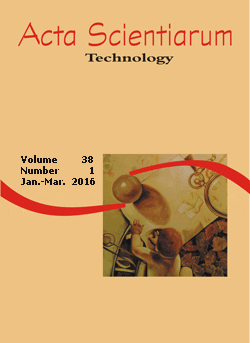<b>Cytotoxic / antioxidant activity and sensorial acceptance of yerba-mate development by oxidation process
DOI:
https://doi.org/10.4025/actascitechnol.v38i1.26033Keywords:
oxidized yerba-mate, antioxidant activity, organoleptic proprietiesAbstract
Yerba-mate (Ilex paraguariensis St. Hil.) is a native species of South America, and its dried leaves are consumed mainly as a beverage. Its phytochemical profile includes phenolic compounds consisting of secondary metabolites with antioxidant activities. Current research optimizes conditions of yerba-mate leaves oxidation, evaluates the sensory acceptance and assesses the in vivo antioxidant activity of the oxidized product. The variables incubation chamber humidity and age of leaves were optimized within the yerba-mate leaves oxidative process by a 22 factorial design. The sensory acceptance and the antioxidant activity of yerba-mate extracts, oxidized by the yeast Saccharomyces cerevisiae exposed to hydrogen peroxide, were assessed. The variables chamber humidity and age of leaves affected the colorimetric coordinates L* and b* during the oxidative process, and validated empirical models. The minimum concentration of beverage-type yerba-mate extract which was able to enhance the cell survival of S. cerevisiae was 150 μgí—mL-1, whilst rate for oxidized product reached 1,200 μgí—mL-1. Extracts from the two processing forms increased the cell survival in S. cerevisiae exposed to 5 mM hydrogen peroxide. The sensory acceptance of oxidized product did not differ significantly when compared to control. The antioxidant activity of yerba-mate extracts should be exploited for the development of new products.
Â
Downloads
Downloads
Published
How to Cite
Issue
Section
License
DECLARATION OF ORIGINALITY AND COPYRIGHTS
I Declare that current article is original and has not been submitted for publication, in part or in whole, to any other national or international journal.
The copyrights belong exclusively to the authors. Published content is licensed under Creative Commons Attribution 4.0 (CC BY 4.0) guidelines, which allows sharing (copy and distribution of the material in any medium or format) and adaptation (remix, transform, and build upon the material) for any purpose, even commercially, under the terms of attribution.
Read this link for further information on how to use CC BY 4.0 properly.



















8.png)




